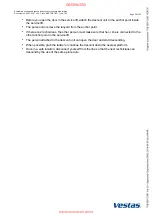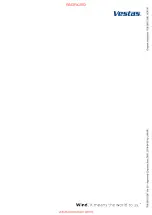
Risk of fall to the ground! SPRA ID No. 1.01
• Do not do work at a height of more than 2 m from the ground unless you wear PPE.
The necessary PPE is given in PPE sheet 8. The PPE must be attached to
approved anchor points.
• Use a ladder or a man basket, as necessary.
• Make sure that there are no persons in the areas where overhead work is done.
See
Evacuation route in the blade (B: Blade)
,
Evacuation routes in the nacelle (N: Nacelle)
,
Evacuation from the nacelle roof (R: Nacelle roof)
,
Evacuation in the yaw deck (Y: Yaw deck)
,
for the evacuation routes.
See
for the escape routes.
Rescue differs from evacuation and escape in that the aim is not to get out of the wind turbine as
fast as possible but to retrieve an injured person safely from the turbine. It will often take longer
time to leave the turbine and sometimes it can be necessary to use a stretcher.
If the injured person is conscious and the injured allows this it is preferable to use normal
evacuation routes.
7.4.1 Rescue route from the blade (B: Blade)
0011461405
Rescue route inside the blade towards the hub. Depending on the injury, the person can be
rescued through the spinner hatch by use of the descent device or by guidance of the person
through the normal evacuation route.
Figure 7.15: Rescue route inside the blade (the blade is locked in horizontal position)
1
To hub
Evacuation, escape and rescue instruction for onshore wind turbine
Document no.: 0067–2397 V00 · Class: RESTRICTED · Type: T09
Page 22 of 33
Содержание V105-3.45 MW
Страница 33: ......



























